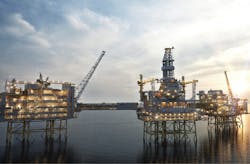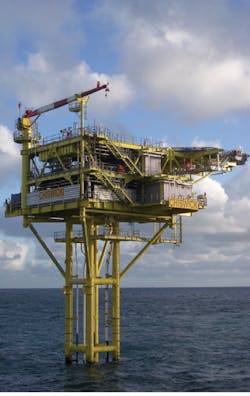Sverdrup drilling ahead of schedule
The Phase 1 Johan Sverdrup field center in the North Sea. (Image courtesy Statoil)
Phase 1 of the Johan Sverdrup field development – Norway’s largest new North Sea project for decades – is around 70% complete, and costs continue to fall. Operator’s Statoil latest capex estimate is $11.21 billion, down 30% on the original figure when the project was approved in August 2015, and the breakeven price is now below $15/bbl.
Margaret Øvrum, the company’s EVP for Technology, Projects & Drilling, said more wells have been drilled than planned at this stage, and this had helped bring down overall costs. Increased use of digital and automated solutions has been another factor. At the same time, drilling results have improved the understanding of the reservoir, leading Statoil to upgrade the Phase 1 recoverable resource range to 2.1-3.1 Bboe.
Phase 1 is due onstream in the second half of 2019. Later this year, the company expects to submit its proposals for Phase 2, involving the addition of a fifth platform and more subsea wells: the current price tag is just under $5.73 billion, which as things stand would mean a breakeven for the full-field development of less than $20/bbl.
Rystad Energy analyst Matthew Fitzsimmons described the Phase 1 reductions as a “remarkable achievement,” bearing in mind that the recent breakeven price for North American shale was over $40/bbl.
BP positive on North Sea area finds
BP has confirmed three discoveries in Norwegian and UK waters, although two were drilled last summer.
The semisubPaul B Loyd Junior encountered oil while drilling the Achmelvich prospect in block 206/9b, close to the giant BP-operated Clair field, and light oil and gas-condensate at Capercaillie in block 29/4e in the UK central North Sea. BP, which is the sole licensee in this block, said it would review options to develop Capercaillie through infrastructure in the area.
In the Norwegian North Sea, Aker BP confounded its own expectations with its oil discovery in the Frosk prospect in license PL340, close to the company’s Alvheim complex. It estimates potential resources in the range 30-60MMboe, well above the pre-drill estimate, and the fresh insight provided into geological conditions in the area result may encourage the partners to pursue other targets.
Throughout 2018, Aker BP expects to participate in 12 exploratory wells offshore Norway, seven as operator, at a total cost to the company of $350 million, with the main focus being on the Barents Sea.
An infill well from the Chiswick platform is one of Spirit Energy’s drilling targets this year. (Photo courtesy Spirit Energy)
Spirit Energy, the new E&P company formed last year which combines the offshore E&P interests formerly held by Centrica and Bayerngas Norge, has spud its first well in the Norwegian Sea, appraising the Fogelberg gas-condensate discovery, northwest of Statoil’s Asgard complex. One of the main aims is to narrow Fogelberg’s recoverable reserves range, previously estimated at 19-116 MMboe.
The company will have five rigs on hire in the North Sea area this year for a program that includes exploratory drilling and P&A. One of the rigs, Noble’s jackup Hans Deul, will drill a new infill well this spring on Spirit’s Chiswick gas field in the UK southern North Sea, which exports gas via a minimal platform to the J6-A complex on the Dutch side of the median line.
Kvaerner to extend Stord quay
Statoil has also issued more major contracts for its multi-field Johan Castberg project in the southern Norwegian Barents Sea, designating Kvaerner for construction of the topsides for the newbuild FPSO, and subsequent hookup and integration with the hull; while Siemens will provide the compression train, comprising a 41-MW SGT-750 gas turbine driving two Datum compressors in a tandem arrangement.
Partly in preparation for this job, Kvaerner plans to invest $47 million in an extended, deeper water quay, 266 m (873 ft) long at its fabrication complex in Stord, western Norway, also expanding the construction area and lengthening the crane lane in order to provide increased coverage from a 1,050-metric ton (1,157-ton) gantry crane installed at the site in 2012. Beyond Castberg, Kvaerner is eyeing outfitting/upgrade work for other deepwater floating platforms, a market it sees as taking off over the next few years.
This summer, Stord will take delivery from Saipem of the topsides, mono-tower and piles from the decommissioned Varg A platform in the southern Norwegian North Sea, for subsequent recycling/disposal.
TAQA eyes new role for Eider Alpha
Many of the UK’s older production platforms are destined for the scrap yards, but Abu Dhabi National Energy Company (TAQA) has a different future in mind for Eider Alpha, 184 km (114 mi) northeast of the Shetlands. Production from the Eider oil field ceased in January, nearly 30 years after start-up. Late last year TAQA completed a bypass project to redirect production from the Otter field – previously sent to this facility – to the North Cormorant platform. It now plans to convert Eider Alpha to a utility platform to extend the lives of other fields in the area, while continuing to provide power, chemical and system support to Otter.



